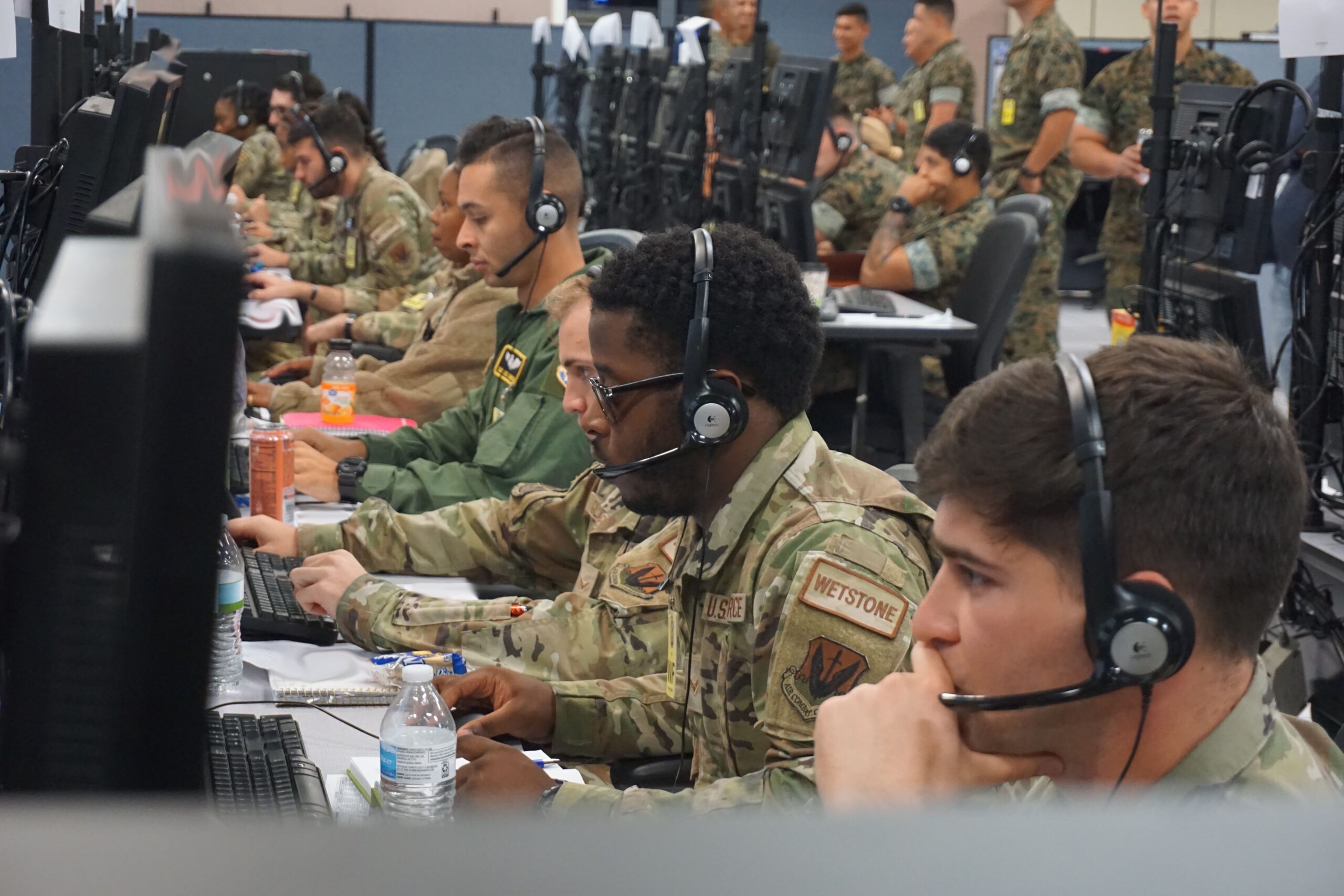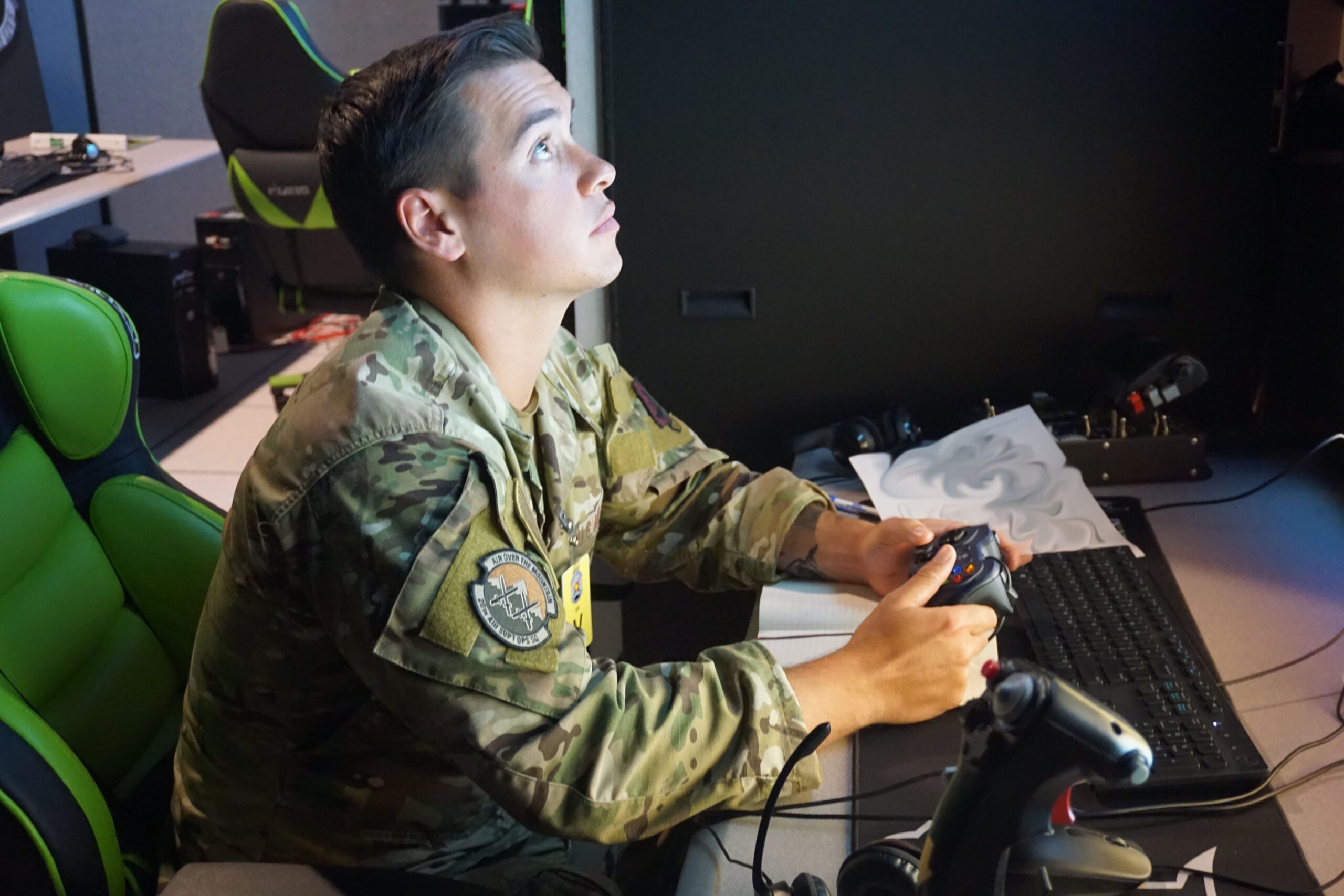The 705th Combat Training Squadron, also known as the Distributed Mission Operations Center, executed exercise VIRTUAL FLAG: Battle Management in a synthetic, joint combat environment, ensuring joint operational and tactical warfighter readiness in the U.S. Indo-Pacific Command area of responsibility at Kirtland Air Force Base, New Mexico, and eight distributed locations.

The DMOC used its live, virtual, and constructive, or LVC, environment capabilities to connect simulators and live aircraft in a dynamic battlespace to challenge air, land, and maritime combatants in the USINDOPACOM AOR and incorporating multiple U.S. Air Force, U.S. Space Force, U.S. Navy, U.S. Marine Corps, and U.S. Army platforms.
“For VIRTUAL FLAG: Battle Management, the DMOC replicated a combat environment, prioritizing agility and sustained command and control capabilities integrating joint warfighters to meet our pacing challenge in the USINDOPACOM AOR,” said U.S. Air Force Maj. Christopher Hawzen, 705th CTS VF exercise director, Kirtland AFB, New Mexico.
Joint military participants traveled from across the U.S. to train and integrate with geographically separated units in scenarios that executed mission-type orders with degraded communications and limited air operations center, or AOC, connectivity.
“The virtual environment allows GSUs to train together for contingency operations or combat without leaving homebases while simultaneously integrating multiple high-end training events,” said Scott Graham, 705th CTS exercise director, Kirtland AFB, New Mexico.

More than 262 operators were trained & 339 readiness training events were accomplished, building experience and familiarizing Airmen, Guardians, Sailors, Marines, and Soldiers in a joint combat environment.
VF: Battle Management’s use of LVC training improved air combat training systems enabling all-domain air dominance in combat against peer- and near-peer adversaries. LVC training also expanded combat operations training by enabling rapid execution of multiple scenarios over a limited time frame; the rapidly adaptable environment encourages learning and builds experience without the time or cost of an exclusively live exercise.
“VIRTUAL FLAG is a great opportunity for us to work with our joint partners face to face and distributed to gain a better understanding of the capabilities we can bring to bear in a joint fight. This exercise gives us a chance to practice tactics, techniques, and procedures that could be used during our next deployment and future war,” U.S. Navy Commander Phillip Boice, Carrier Strike Group NINE deputy operations officer for commander/Navy VF lead, North Island Naval Air Station, California.
The flag-level exercise involved E-3C Airborne Warning and Control Systems, E-8C Joint Surveillance Target Attack Systems, RC-135V/W Rivet Joints, MQ-9 Reapers, C-17 Globemaster IIIs, E-2 Hawkeyes, P-8 Poseidons, MH-60 and MH-60R Seahawks, AN/GSQ-272 SENTINEL weapon systems and the U.S. Marine Corps Multi-Function Air Operations Center and U.S. Air Force Control and Reporting Center.

“One thing never changes: the DMOC enables warfighters to sharpen their combat skills in a live, fast-paced, and realistic joint training environment,” said Hawzen.
VF also integrated kinetics with non-kinetics effects to practice wartime tactics in a degraded environment. One of the major non-kinetic players in VF 22-4 was the cyberspace element which integrated cyberspace to support the defense of an AOC and a CRC.
The cyberspace defensive force was composed of members from the 834th Cyberspace Operations Squadron, 92d Cyberspace Operations Squadron, 552d Air Control Networks Squadron mission defense team, and the U.S. Marine Corps’ 9th Communication Battalion. The teams defended against Advanced Persistent Threats, or APTs, whose objectives were to gather critical tasking orders and data from the AOC and to deny, delay, disrupt, destroy, and manipulate, or D4M, the AOC during operations. The defensive units hunted and cleared the APTs on the network so that the cyber attackers could not achieve their objectives.
“Integrating cyberspace into flying exercises like this supports the education of the flying community as to what capabilities and threats are present within the cyberspace domain. It also helps our cyberspace forces expand their knowledge of the joint fight and how it integrates into the other domains of warfare, preparing both sides for the joint concept of all-domain warfare,” said U.S. Air Force Capt. Travis Britton, 834th Cyberspace Operations Squadron Weapons and Tactics chief, Joint Base San Antonio, Texas.
The 805th Combat Training Squadron’s Shadow Operations Center-Nellis with direction from the 318th Cyber Operations Group, Detachment 2, planned, organized, and executed red team actions during VF. The red team included Air Force and Marine Corps personnel assigned to execute actions according to desired learning objectives from the 552d ACNS’s E-3 Sentry AWACS mission defense team and 834th COS cyber protection team.
“The ShOC-N stands as the vanguard beacon of efforts to engage current and future pacing challenges. In this regard, performing red team actions within the VIRTUAL FLAG: Battle Management construct helped ShOC personnel develop penetration testing skills that are vastly needed during experimentation within the confines of our Air Force Battle Lab,” said U.S. Air Force Lt. Col. Shawn Finney, 805th CTS/ShOC-N operations officer, Nellis AFB, Nevada.
Guardians from the 310th Space Wing, an Air Force Reserve unit, honed their skills while providing warning of inbound enemy missiles, analyzing degradation of global positioning signals caused by jammers, as well as sharing and analysis of electronic intelligence and overhead persistent infrared data from satellites, and providing valuable information that helps the warfighter understand the threats they face on the battlefield.
“VIRTUAL FLAG exercises provide a superb opportunity to train space operators in a joint environment,” said Walt Marvin, 392d Combat Training Squadron exercise planner, Schriever Space Force Base, Colorado. “Our space element learned their role very quickly and ensured that support from the space domain played an integral part in mission accomplishment on the tactical battlefield.”
During VF, air battle managers and tactical air control party, or TACP, Airmen traveled to Kirtland from across Air Combat Command, Pacific Air Forces, and U.S. Air Forces in Europe to participate in the experiment executed the third Tactical Operations Center – Light experiment iteration. The experiment was designed to continue development of future C2, concepts intended to expedite kill chains and improve distributed battle management.
“The 705th CTS team has been extremely supportive in our efforts to leverage their capabilities and expertise to experiment with these concepts. Integrating within VIRTUAL FLAG: Battle Management provided exposure to unique tactical problem sets and an amplified intensity from our previous experiment iterations, which enabled the team to make strides in our collaborative experimentation,” said U.S. Air Force Maj. Dustin Nedolast, 505th Command and Control Wing, Detachment 1 experiment director, Fort Leavenworth, Kansas.
VF: Battle Management executed 8-hour vulnerability windows allowing C2 over time and enabling participants to work through force and battle management challenges across all five domains from start to finish.
“Although we have been conducting VIRTUAL FLAG exercises for more than 21 years, the mission and execution have changed dramatically,” said U.S. Air Force Lt. Col. Michael Butler, 705th CTS commander, Kirtland AFB, New Mexico. “We’re constantly evolving to meet the needs of joint and coalition warfighters, adding elements, changing threats – anything that a pacing challenge may present, we want to address at the DMOC.”
The exercise also included the use of condition-based authorities, which enabled tactical C2 units to train mission commanders, contested logistics problem sets, and a dedicated mission planning cell that operated concurrently with execution.
“Technology, equipment, and participants change. The DMOC’s use of LVC training environment prepares joint and coalition warfighters for any pacing challenge,” said U.S. Air Force Col. Aaron Gibney, 505th Combat Training Group commander, Nellis Air Force Base, Nevada.
Deb Henley
505th Command and Control Wing
Public Affairs

